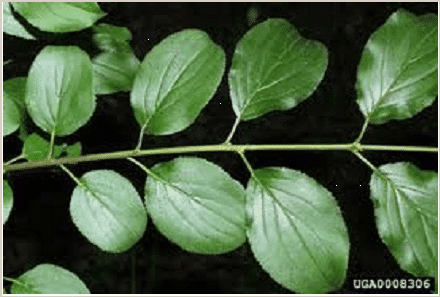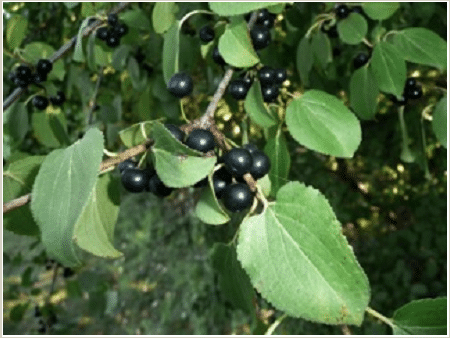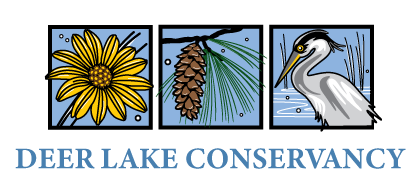Buckthorn Eradication
Terrestial Invasive Species at Deer Lake: European Buckthorn

Secondly, there is a tipping point with local buckthorn invasions. No North American tree can keep up with the phenomenal growth of a buckthorn seedbed. In a wet spring, like we’re experiencing in northwestern Wisconsin in 2013, buckthorn seedlings will grow more than one inch per day. Once established, buckthorn is extremely difficult if not impossible to eradicate. Yes, the proud crown of a specimen Northern red oak (Quercus rubra) will remain around Deer Lake for decades to come, but if the understory becomes a dense buckthorn monoculture there will be no acorn self-sowing. Permanent removal means much more that a one-time cutting of a buckthorn tree. In fact, a one-time cutting will only exacerbate the problem because of (1.) root regeneration of sprouts ten-fold, and (2.) seed in the soil that will continue to be viable for up to seven years.
Unlike the Deer Lake Aquatic Plan Management (APM) with Wisconsin DNR involvement, control of terrestrial invasive species relies on vigilance by each individual Deer Lake landowner. It requires a scientific approach even with the smallest plot of land. Many parks and agricultural facilities around the Upper Midwest use an Integrated Pest Management (IPM) for buckthorn control. A typical IPM not only prescribes manual removal including the roots, but also the prudent use of herbicides. Dow AgroSciences Garlon 4 with triclopyr is the chemical of choice for large infestations, but over-the-counter glyphosate (Round-up) and low-dose triclopyr (Brush-B-Gone) have a place in the short-term battle. The Internet is a valuable source on how to use the chemicals safely and effectively to control the buckthorn invasion.
This is not a new concern at Deer Lake; the following is an excerpt from the fall, 2010 Deer Tales newsletter.
- Trees greater than 3’ should be cut down and the stump should be treated with a chemical (some type of Round-up) or dug completely out. After four years a tree can look almost normal again if the stump is not treated.
- Trees between 1’ – 3’ could be cut down and then either completely remove the stump or treat the stump chemically.
- Trees less than 1’ should be easily pulled out. [Note: this will require thick gloves and some pretty strong muscle power – a large “weed wrench” can be purchased to help with this method of removal.
Here’s a buckthorn pointer for the month of June. Late spring is the time to look for numerous fast-growing seedlings with shiny green leaves. No other woody seedlings will have the same pace of growth. The larger adult male buckthorn trees will be developing small stamens but the female trees will blend in with the landscape until bearing an inky-black fruit later in the summer.
Buckthorn pointer for the month of July. Mid-summer inevitably brings the early development of green pea-sized fruit to the mature female European buckthorn trees. Identification for purposes of buckthorn removal must be done with great caution because our lovely black cherry tree (Prunus serotina) will have the same sized green fruit in July. The invasive species once again has a competitive advantage because it will produce many clusters of green berries that will have several seeds per berry while the native black cherry tree will have singular drupes with only one seed per pit.
Buckthorn pointer for the month of August. The berries on the female European buckthorn will be turning an inky black color during the month of August. One of the qualities that enable the invasive buckthorn to spread so readily is the fact that the fruit ripens in advance of the fruit on most native trees. The swallows are lining up on the power lines, the robins are already flocking, and, with perfect timing, this ripe laxative is available. Look for the thorns, shiny green leaves, and the dark fruit for positive identification. It’s a good time to remove European buckthorn trees before the hungry birds begin the cycle of spreading the noxious weed for yet another year.

In September, the European buckthorn berries are fully ripe. Because of the current hard-baked soil, these berries are a plentiful substitute food for flocking robins. European earthworms (there are no native North American earthworms) presently reside deep below the dry surface soil. This is a win-win situation for buckthorn seed dispersal and the alien earthworms.
By October the leaves on the native deciduous trees are turning color and falling to the ground, but the buckthorn leaves are still a very bright green and will remain that way until mid-winter. It is especially easy to identify new growths of buckthorn among the herbaceous plants because there will be no wilting or color change in these low-level sprouts. It should be quite easy to reach down and pull them out of the ground (roots and all).
November is the month for action in the buckthorn battle. Temperatures get below freezing at night and morning surface frosts have arrived, but, unlike native trees, the alien buckthorn still holds its green leaves. As long as the ground remains unfrozen it’s a great time to organize an annual “buckthorn pull.” Many environmental groups, including the Audubon Society, use this time of year to fulfill their mission of protecting native species.
This article on Buckthorn has been prepared and submitted by Rick Radder. Rick has owned his hillside cottage on the west shore of Deer Lake since 1989. Rick earned his Master of Public Health degree in Environmental Health from the University of Minnesota in 2012. His master’s thesis was entitled “Rhamnus cathartica, An Integrated Pest Management Approach.” Please check this page for future updates throughout the seasons.
